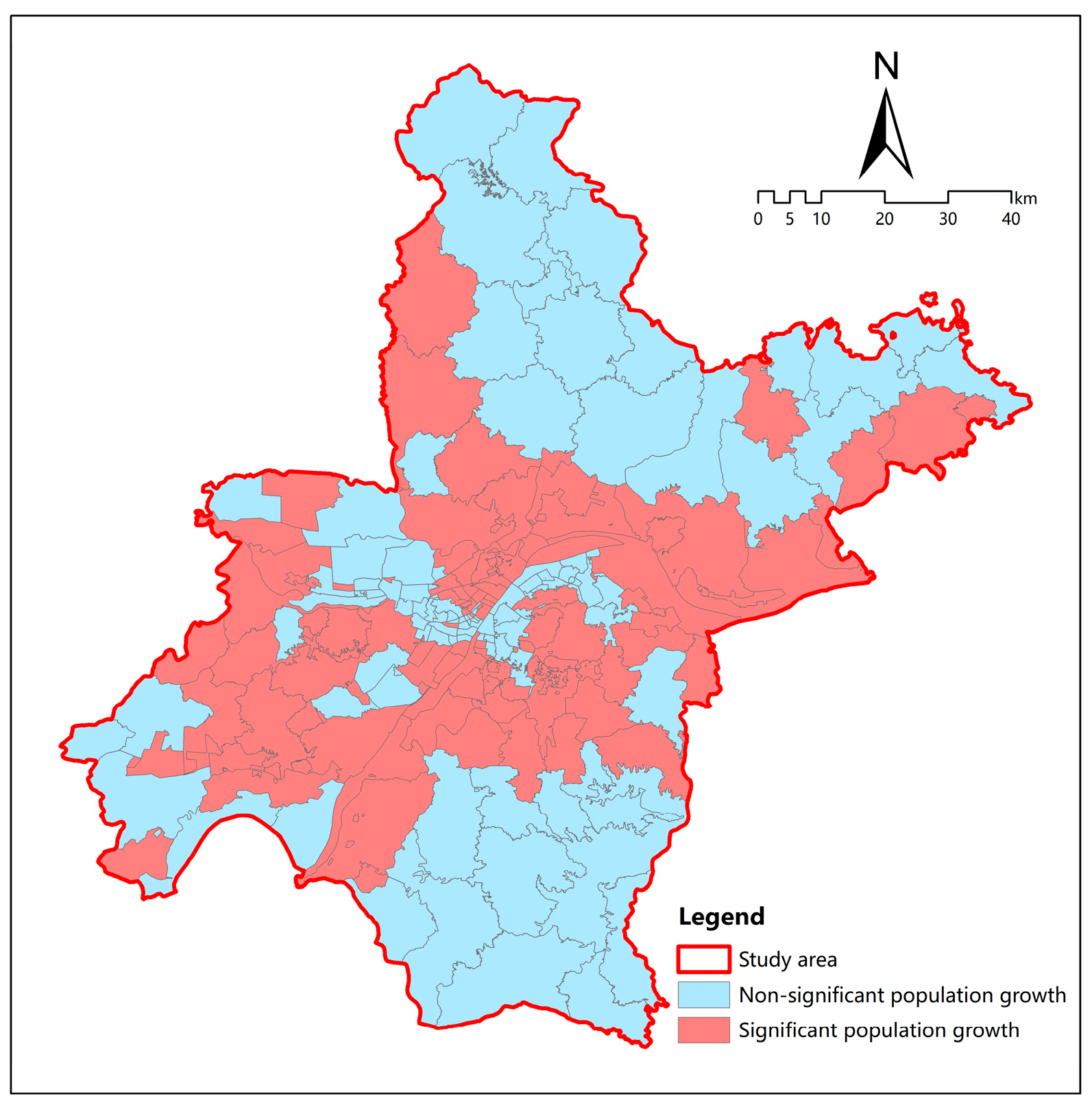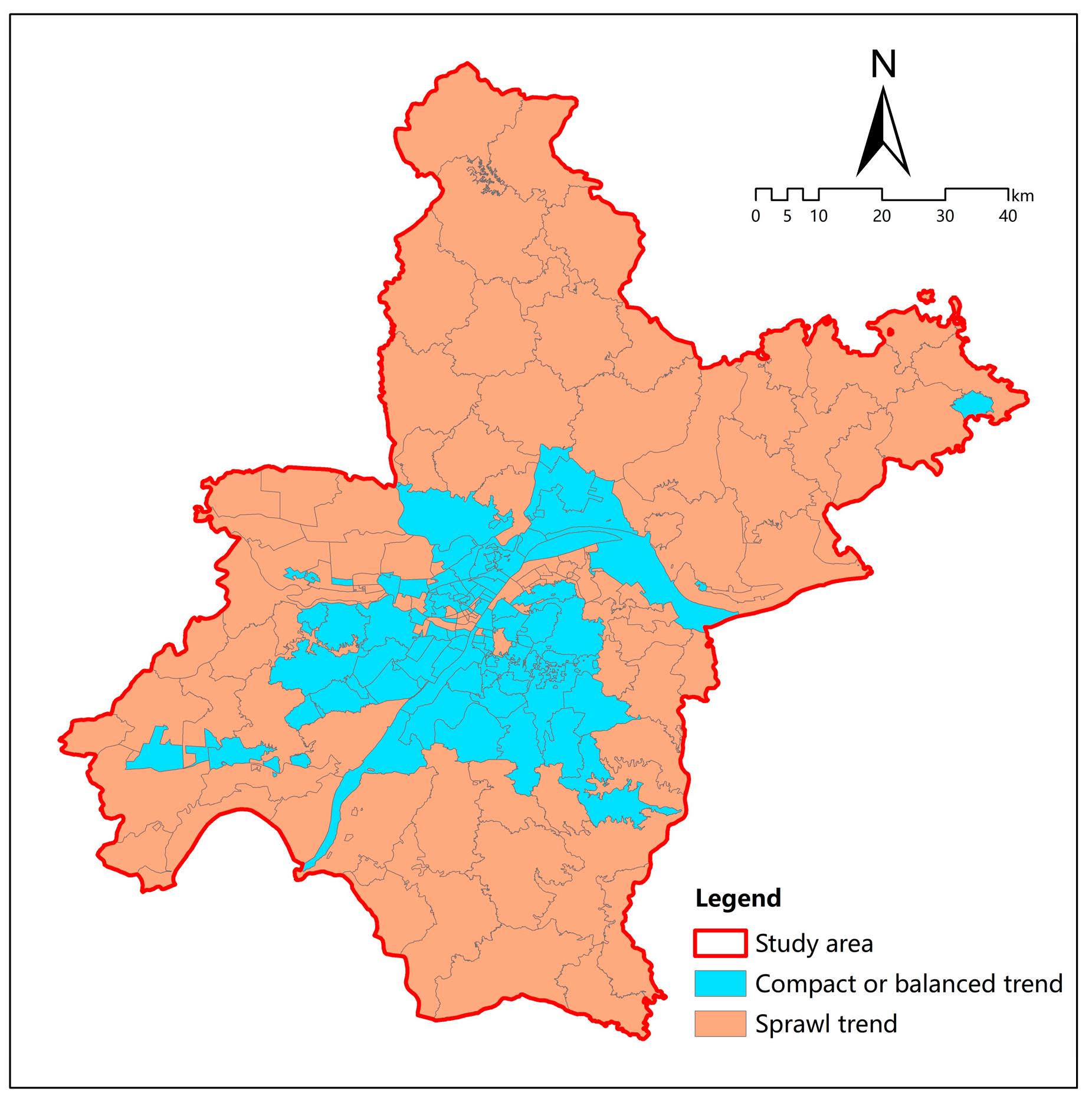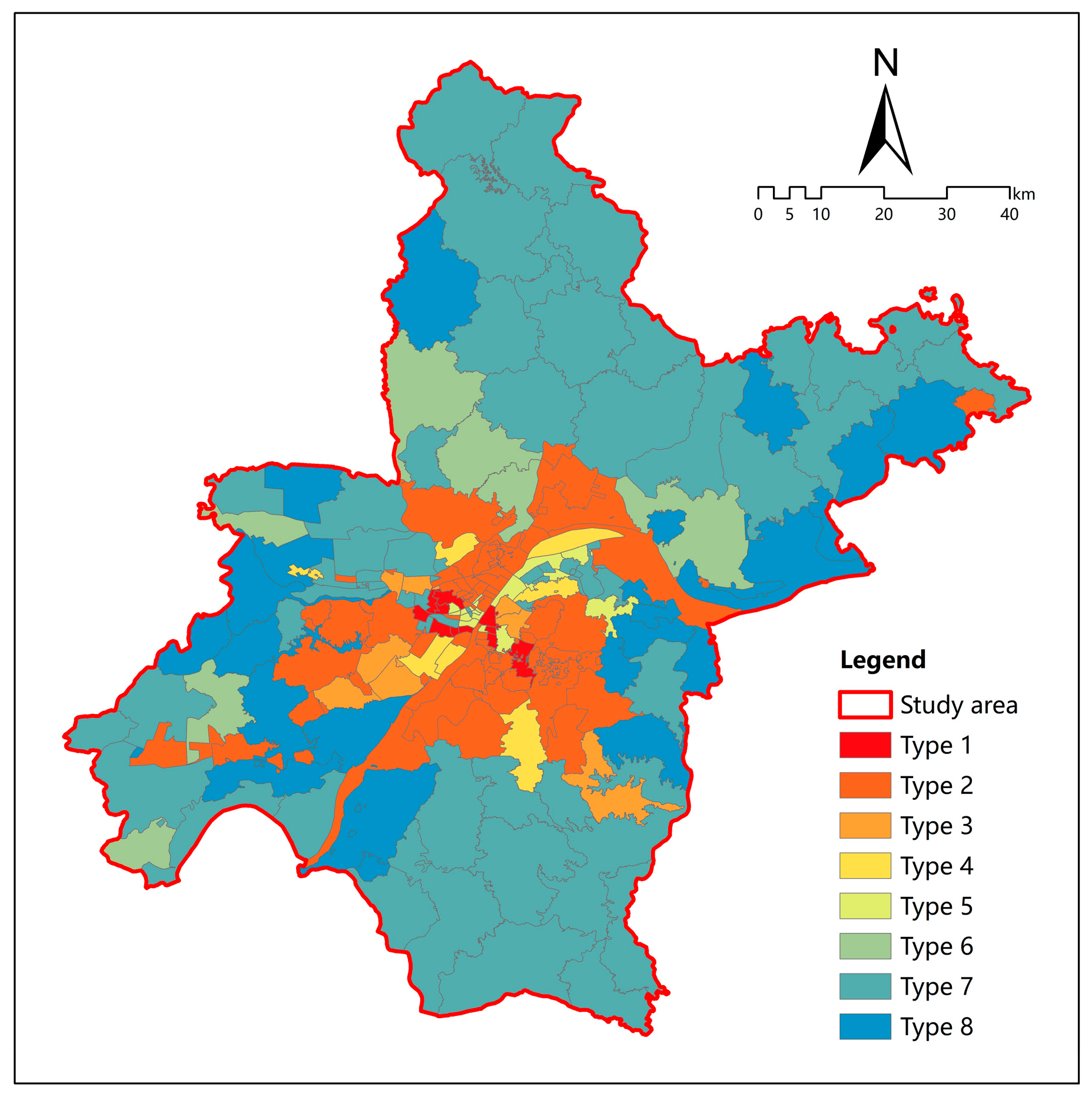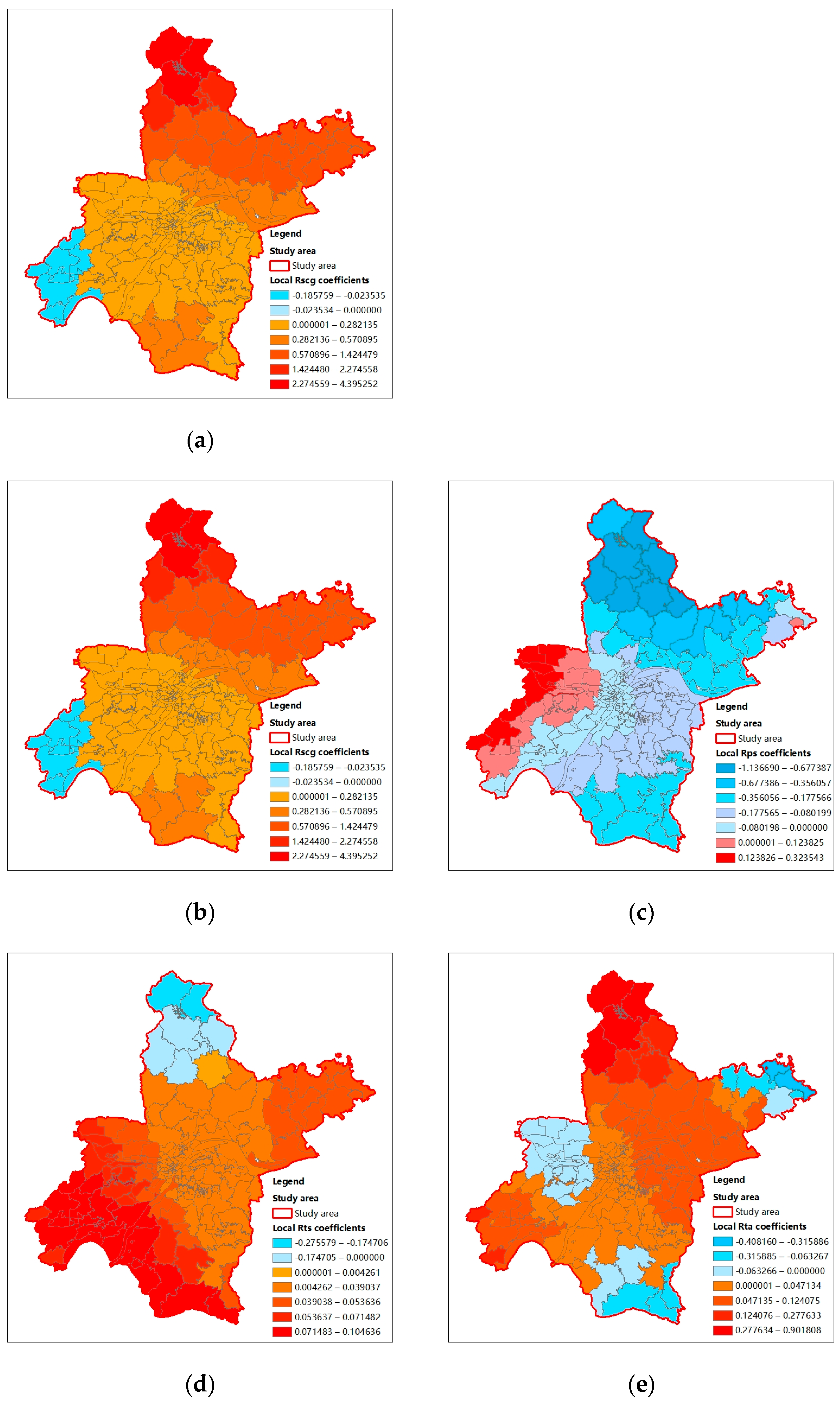Characterizing Sprawl Development in Urban China: A Perspective from Urban Amenity
Abstract
1. Introduction
2. Materials
2.1. Study Area
2.2. Data Source
2.3. Methods
2.3.1. Land Use Identification
2.3.2. Modeling Characteristics of Urban Sprawl
3. Development Patterns in Wuhan
3.1. Demographic Development
3.2. Patterns of Urban Land Use Expansion
3.3. Sprawl or Compact? Development Trends Based on Population and Land Use
3.4. Development Trends Based on Population, Land Use, and Urban Amenity in Wuhan
4. Characteristics of Urban Sprawl in Wuhan
4.1. Regression Results of the Spatial Filtering Regression
4.2. Regression Results of the GWR Model
5. Discussion
6. Conclusions
Author Contributions
Funding
Data Availability Statement
Conflicts of Interest
References
- Wei, Y.H.D.; Ewing, R. Urban expansion, sprawl and inequality. Landsc. Urban Plan. 2018, 177, 259–265. [Google Scholar] [CrossRef]
- Carneiro, E.; Lopes, W.; Espindola, G. Linking Urban Sprawl and Surface Urban Heat Island in the Teresina–Timon Conurbation Area in Brazil. Land 2021, 10, 516. [Google Scholar] [CrossRef]
- Yang, X.; Wang, J.; Cao, J.; Ren, S.; Ran, Q.; Wu, H. The spatial spillover effect of urban sprawl and fiscal decentralization on air pollution: Evidence from 269 cities in China. Empir. Econ. 2022, 63, 847–875. [Google Scholar] [CrossRef]
- Guo, C.; Buchmann, C.M.; Schwarz, N. Linking urban sprawl and income segregation—Findings from a stylized agent-based model. Environ. Plan. B Urban Anal. City Sci. 2019, 46, 469–489. [Google Scholar] [CrossRef]
- Deng, Y.; Qi, W.; Fu, B.; Wang, K. Geographical transformations of urban sprawl: Exploring the spatial heterogeneity across cities in China 1992–2015. Cities 2020, 105, 102415. [Google Scholar] [CrossRef]
- Qin, X.; Wei, Y.D.; Yu, Z.; Xiong, N. Urbanization, Suburbanization, and Population Redistribution in Urban China: A Case Study of Nanjing. J. Urban Plan. Dev. 2022, 148, 05022034. [Google Scholar] [CrossRef]
- Zhang, X.; Shen, J.; Sun, Y.; Zhou, C.; Yang, Y. Formation of City Regions from Bottom-up Initiatives: Investigating Coalitional Developmentalism in the Pearl River Delta. Ann. Am. Assoc. Geogr. 2023, 113, 700–716. [Google Scholar] [CrossRef]
- Zhang, X.; Li, Y.; Zhou, C.; Luan, X.; Yuan, F. Rescaling of the land regime in the making of city-regions: A case study of China’s Pearl River Delta. Urban Stud. 2023, 60, 483–500. [Google Scholar] [CrossRef]
- Walker, R.A. A theory of suburbanization: Capitalism and the construction of urban space in the United States. In Urbanization and Urban Planning in Capitalist Society; Routledge: London, UK, 2018; pp. 383–429. [Google Scholar]
- Byun, P.; Esparza, A.X. A Revisionist Model of Suburbanization and Sprawl. J. Plan. Educ. Res. 2016, 24, 252–264. [Google Scholar] [CrossRef]
- Ismael, H.M. Urban form study: The sprawling city—Review of methods of studying urban sprawl. GeoJournal 2020, 86, 1785–1796. [Google Scholar] [CrossRef]
- Wang, X.; Shi, R.; Zhou, Y. Dynamics of urban sprawl and sustainable development in China. Socio-Econ. Plan. Sci. 2020, 70, 100736. [Google Scholar] [CrossRef]
- Midler, M.; Dubcova, A. Commercial Suburbanization of Nitra City (Case Study Cerman District). In Proceedings of the 24th International PhD Students Conference (MendelNet 2017), Brno, Czech Republic, 8–9 November 2017; pp. 407–412. [Google Scholar]
- Mera, K.; Renaud, B. Asia’s Financial Crisis and the Role of Real Estate; Routledge: London, UK, 2016. [Google Scholar]
- Eren, F. Does the Asian property market work for sustainable urban developments? In Sustainable Cities in Asia; Routledge: London, UK, 2017; pp. 32–47. [Google Scholar]
- Liu, Y.; Fan, P.; Yue, W.; Song, Y. Impacts of land finance on urban sprawl in China: The case of Chongqing. Land Use Policy 2018, 72, 420–432. [Google Scholar] [CrossRef]
- Zhao, P. Managing urban growth in a transforming China: Evidence from Beijing. Land Use Policy 2011, 28, 96–109. [Google Scholar] [CrossRef]
- Jia, M.; Liu, Y.; Lieske, S.N.; Chen, T. Public policy change and its impact on urban expansion: An evaluation of 265 cities in China. Land Use Policy 2020, 97, 104754. [Google Scholar] [CrossRef]
- Frederic Deng, F.; Huang, Y. Uneven land reform and urban sprawl in China: The case of Beijing. Prog. Plan. 2004, 61, 211–236. [Google Scholar] [CrossRef]
- Yan, Y.; Liu, T.; Wang, N.; Yao, S. Urban sprawl and fiscal stress: Evidence from urbanizing China. Cities 2022, 126, 103699. [Google Scholar] [CrossRef]
- Wu, J.; Yu, Z.; Wei, Y.D.; Yang, L. Changing distribution of migrant population and its influencing factors in urban China: Economic transition, public policy, and amenities. Habitat Int. 2019, 94, 102063. [Google Scholar] [CrossRef]
- Wang, X. Relationship between Population Urbanization and Urban Sprawl Across Different City Sizes in China. Environ. Urban. ASIA 2021, 12, 202–219. [Google Scholar] [CrossRef]
- Liu, Y.; Zhou, Y. Territory spatial planning and national governance system in China. Land Use Policy 2021, 102, 105288. [Google Scholar] [CrossRef]
- Yang, Y.; Zhang, L.; Ye, Y.; Wang, Z. Curbing Sprawl with Development-limiting Boundaries in Urban China: A Review of Literature. J. Plan. Lit. 2020, 35, 25–40. [Google Scholar] [CrossRef]
- Bhatta, B.; Saraswati, S.; Bandyopadhyay, D. Urban sprawl measurement from remote sensing data. Appl. Geogr. 2010, 30, 731–740. [Google Scholar] [CrossRef]
- Frenkel, A.; Ashkenazi, M. Measuring Urban Sprawl: How Can We Deal with It? Environ. Plan. B Plan. Des. 2008, 35, 56–79. [Google Scholar] [CrossRef]
- Oueslati, W.; Alvanides, S.; Garrod, G. Determinants of urban sprawl in European cities. Urban Stud. 2015, 52, 1594–1614. [Google Scholar] [CrossRef] [PubMed]
- Ewing, R.; Hamidi, S. Compactness versus Sprawl:A Review of Recent Evidence from the United States. J. Plan. Lit. 2015, 30, 413–432. [Google Scholar] [CrossRef]
- Wu, Y.; Wei, Y.D.; Liu, M. Urban Form and Spatiotemporal Vulnerability of Local Communities to COVID-19. Geogr. Rev. 2022, 1–20. [Google Scholar] [CrossRef]
- Wei, Y.H.D. Planning Chinese cities: The limits of transitional institutions. Urban Geogr. 2005, 26, 200–221. [Google Scholar] [CrossRef]
- Kim, J. Eating outdoors: An inscription–prescription analysis of user behaviour in public spaces. Urban Des. Int. 2019, 24, 280–295. [Google Scholar] [CrossRef]
- Zhou, L.; Dang, X.; Sun, Q.; Wang, S. Multi-scenario simulation of urban land change in Shanghai by random forest and CA-Markov model. Sustain. Cities Soc. 2020, 55, 102045. [Google Scholar] [CrossRef]
- Bertaud, A. Order without design: How markets shape cities. Town Reg. Plan. 2021, 79, 2–5. [Google Scholar]
- He, Q.; Musterd, S.; Boterman, W. Geographical structure of the local segregation of migrants in (sub)urban China. GeoJournal 2023, 88, 1449–1467. [Google Scholar] [CrossRef]
- Wu, F. Scripting Indian and Chinese urban spatial transformation: Adding new narratives to gentrification and suburbanisation research. Environ. Plan. C Politics Space 2020, 38, 980–997. [Google Scholar] [CrossRef]
- Surya, B.; Salim, A.; Hernita, H.; Suriani, S.; Menne, F.; Rasyidi, E.S. Land Use Change, Urban Agglomeration, and Urban Sprawl: A Sustainable Development Perspective of Makassar City, Indonesia. Land 2021, 10, 556. [Google Scholar] [CrossRef]
- Glaeser, E.L.; Kourtit, K.; Nijkamp, P. Urban Empires Cities as Global Rulers in the New Urban World; Routledge: New York, NY, USA, 2020. [Google Scholar]
- Wu, W.; Chen, W.Y.; Yun, Y.; Wang, F.; Gong, Z. Urban greenness, mixed land-use, and life satisfaction: Evidence from residential locations and workplace settings in Beijing. Landsc. Urban Plan. 2022, 224, 104428. [Google Scholar] [CrossRef]
- Chen, J.; Gao, J.; Yuan, F.; Wei, Y. Spatial Determinants of Urban Land Expansion in Globalizing Nanjing, China. Sustainability 2016, 8, 868. [Google Scholar] [CrossRef]
- Varade, D.; Singh, H.; Singh, A.P.; Awasthi, S. Assessment of urban sprawls, amenities, and indifferences of LST and AOD in sub-urban area: A case study of Jammu. Environ. Sci. Pollut. Res. 2023. [Google Scholar] [CrossRef]
- Zhu, W.; Wang, J.; Qin, B. Quantity or quality? Exploring the association between public open space and mental health in urban China. Landsc. Urban Plan. 2021, 213, 104128. [Google Scholar] [CrossRef]
- Xiao, W.; Wei, Y.D. Assess the non-linear relationship between built environment and active travel around light-rail transit stations. Appl. Geogr. 2023, 151, 102862. [Google Scholar] [CrossRef]
- He, J.; Song, Y.; Huang, X.; Lin, J. An amenity-based approach to excellent returning scientists’ location choice in China. Pap. Reg. Sci. 2022, 101, 1181–1197. [Google Scholar] [CrossRef]
- Zhang, S.; Zheng, H.; Zhou, H.; Shao, Q.; Wu, Q. Sustainable land urbanization, urban amenities, and population urbanization: Evidence from city-level data in China. Soc. Sci. Q. 2021, 102, 1686–1698. [Google Scholar] [CrossRef]
- Wang, M. Polycentric urban development and urban amenities: Evidence from Chinese cities. Environ. Plan. B Urban Anal. City Sci. 2020, 48, 400–416. [Google Scholar] [CrossRef]
- Xia, C.; Yeh, A.G.-O.; Zhang, A. Analyzing spatial relationships between urban land use intensity and urban vitality at street block level: A case study of five Chinese megacities. Landsc. Urban Plan. 2020, 193, 103669. [Google Scholar] [CrossRef]
- Li, H.; Wei, Y.D.; Wu, Y.; Tian, G. Analyzing housing prices in Shanghai with open data: Amenity, accessibility and urban structure. Cities 2019, 91, 165–179. [Google Scholar] [CrossRef]
- Gazzeh, K.; Abubakar, I.R. Regional disparity in access to basic public services in Saudi Arabia: A sustainability challenge. Util. Policy 2018, 52, 70–80. [Google Scholar] [CrossRef]
- Wu, Y.; Wei, Y.D.; Li, H.; Liu, M. Amenity, firm agglomeration, and local creativity of producer services in Shanghai. Cities 2022, 120, 103421. [Google Scholar] [CrossRef]
- Long, Y.; Gao, S. Shrinking cities in China: The overall profile and paradox in planning. In Shrinking Cities in China: The Other Facet of Urbanization; Springer: Singapore, 2019; pp. 3–21. [Google Scholar]
- Zhu, X.; Yao, D.; Shi, H.; Qu, K.; Tang, Y.; Zhao, K. The Evolution Mode and Driving Mechanisms of the Relationship between Construction Land Use and Permanent Population in Urban and Rural Contexts: Evidence from China’s Land Survey. Land 2022, 11, 1721. [Google Scholar] [CrossRef]
- Shao, Z.; Sumari, N.S.; Portnov, A.; Ujoh, F.; Musakwa, W.; Mandela, P.J. Urban sprawl and its impact on sustainable urban development: A combination of remote sensing and social media data. Geo-Spat. Inf. Sci. 2021, 24, 241–255. [Google Scholar] [CrossRef]
- Wang, Q.; Wang, H. Spatiotemporal dynamics and evolution relationships between land-use/land cover change and landscape pattern in response to rapid urban sprawl process: A case study in Wuhan, China. Ecol. Eng. 2022, 182, 106716. [Google Scholar] [CrossRef]
- Long, Y.; Song, Y.; Chen, L. Identifying subcenters with a nonparametric method and ubiquitous point-of-interest data: A case study of 284 Chinese cities. Environ. Plan. B Urban Anal. City Sci. 2021, 49, 58–75. [Google Scholar] [CrossRef]
- Qin, B.; Zhang, Y. Note on urbanization in China: Urban definitions and census data. China Econ. Rev. 2014, 30, 495–502. [Google Scholar] [CrossRef]
- Espindola, G.M.d.; Carneiro, E.L.N.d.C.; Façanha, A.C. Four decades of urban sprawl and population growth in Teresina, Brazil. Appl. Geogr. 2017, 79, 73–83. [Google Scholar] [CrossRef]
- Chen, D.; Lu, X.; Liu, X.; Wang, X. Measurement of the eco-environmental effects of urban sprawl: Theoretical mechanism and spatiotemporal differentiation. Ecol. Indic. 2019, 105, 6–15. [Google Scholar] [CrossRef]
- Zhang, L.; Wei, Y.; Meng, R. Spatiotemporal Dynamics and Spatial Determinants of Urban Growth in Suzhou, China. Sustainability 2017, 9, 393. [Google Scholar] [CrossRef]
- Feng, Y.; Liu, Y.; Tong, X. Spatiotemporal variation of landscape patterns and their spatial determinants in Shanghai, China. Ecol. Indic. 2018, 87, 22–32. [Google Scholar] [CrossRef]
- Wuhan Bureau of Statistics. Wuhan Statistical Yearbook; Wuhan Bureau of Statistics: Wuhan, China, 2016; pp. 3–4. [Google Scholar]
- Wuhan Bureau of Statistics. Wuhan Statistical Yearbook; Wuhan Bureau of Statistics: Wuhan, China, 2022; pp. 3–4. [Google Scholar]
- Zhou, K.; Tan, R. More Than Thirty Years of Environmentally Sensitive Area Loss in Wuhan: What Lessons Have We Learned from Urban Containment Policy? Land 2022, 11, 1310. [Google Scholar] [CrossRef]
- Jiao, H.; Li, C.; Yu, Y.; Peng, Z. Urban Public Green Space Equity against the Context of High-Speed Urbanization in Wuhan, Central China. Sustainability 2020, 12, 9394. [Google Scholar] [CrossRef]
- Micijevic, E.; Haque, M.O.; Scaramuzza, P.; Storey, J.; Anderson, C.; Markham, B.; Neeck, S.P.; Kimura, T.; Martimort, P. Landsat 9 pre-launch sensor characterization and comparison with Landsat 8 results. In Proceedings of the Sensors, Systems, and Next-Generation Satellites XXIII, Strasbourg, France, 9–12 September 2019. [Google Scholar]
- Butler, J.J.; Xiong, X.; Gu, X.; Markham, B.L.; Jenstrom, D.; Masek, J.G.; Dabney, P.; Pedelty, J.A.; Barsi, J.A.; Montanaro, M. Landsat 9: Status and plans. In Proceedings of the Earth Observing Systems XXI, San Diego, CA, USA, 28 August–1 September 2016. [Google Scholar]
- Milias, V.; Psyllidis, A. Assessing the influence of point-of-interest features on the classification of place categories. Comput. Environ. Urban Syst. 2021, 86, 101597. [Google Scholar] [CrossRef]
- Glaeser, E.L.; Kolko, J.; Saiz, A. Consumer city. J. Econ. Geogr. 2000, 27–50. [Google Scholar]
- Calka, B.; Bielecka, E. Reliability Analysis of LandScan Gridded Population Data. The Case Study of Poland. ISPRS Int. J. Geo-Inf. 2019, 8, 222. [Google Scholar] [CrossRef]
- Xu, H. Modification of normalised difference water index (NDWI) to enhance open water features in remotely sensed imagery. Int. J. Remote Sens. 2006, 27, 3025–3033. [Google Scholar] [CrossRef]
- Huang, S.; Tang, L.; Hupy, J.P.; Wang, Y.; Shao, G. A commentary review on the use of normalized difference vegetation index (NDVI) in the era of popular remote sensing. J. For. Res. 2021, 32, 1–6. [Google Scholar] [CrossRef]
- Zheng, Y.; Tang, L.; Wang, H. An improved approach for monitoring urban built-up areas by combining NPP-VIIRS nighttime light, NDVI, NDWI, and NDBI. J. Clean. Prod. 2021, 328, 129488. [Google Scholar] [CrossRef]
- Feng, Y.; Wang, X.; Du, W.; Liu, J.; Li, Y. Spatiotemporal characteristics and driving forces of urban sprawl in China during 2003–2017. J. Clean. Prod. 2019, 241, 118061. [Google Scholar] [CrossRef]
- Murakami, D.; Griffith, D.A. Eigenvector Spatial Filtering for Large Data Sets: Fixed and Random Effects Approaches. Geogr. Anal. 2019, 51, 23–49. [Google Scholar] [CrossRef]
- Zhu, C.; Zhang, X.; Zhou, M.; He, S.; Gan, M.; Yang, L.; Wang, K. Impacts of urbanization and landscape pattern on habitat quality using OLS and GWR models in Hangzhou, China. Ecol. Indic. 2020, 117, 106654. [Google Scholar] [CrossRef]
- Liu, Y.; Shu, L.; Peng, L. The Hollowing Process of Rural Communities in China: Considering the Regional Characteristic. Land 2021, 10, 911. [Google Scholar] [CrossRef]
- Li, Q.; Xu, Y.; Yang, X.; Chen, K. Unveiling the Regional Differences and Convergence of Urban Sprawl in China, 2006–2019. Land 2023, 12, 152. [Google Scholar] [CrossRef]
- Yaping, W.; Min, Z. Urban spill over vs. local urban sprawl: Entangling land-use regulations in the urban growth of China’s megacities. Land Use Policy 2009, 26, 1031–1045. [Google Scholar] [CrossRef]
- Barnett, A.; Van Dyck, D.; Van Cauwenberg, J.; Zhang, C.J.P.; Lai, P.C.; Cerin, E. Objective neighbourhood attributes as correlates of neighbourhood dissatisfaction and the mediating role of neighbourhood perceptions in older adults from culturally and physically diverse urban environments. Cities 2020, 107, 102879. [Google Scholar] [CrossRef]
- Ingersoll, R. Sprawltown: Looking for the City on Its Edges; Princeton Architectural Press: Hudson, NY, USA, 2006. [Google Scholar]
- Zhuang, T.; Qian, Q.K.; Visscher, H.J.; Elsinga, M.G. Stakeholders’ Expectations in Urban Renewal Projects in China: A Key Step towards Sustainability. Sustainability 2017, 9, 1640. [Google Scholar] [CrossRef]
- Wu, Y.; Wei, Y.D.; Li, H. Firm Suburbanization in the Context of Urban Sprawl: Neighborhood Effect and Sectoral Difference. Prof. Geogr. 2020, 72, 598–617. [Google Scholar] [CrossRef]
- Yuan, F.; Wu, J.W.; Wei, Y.H.D.; Wang, L. Policy change, amenity, and spatiotemporal dynamics of housing prices in Nanjing, China. Land Use Policy 2018, 75, 225–236. [Google Scholar] [CrossRef]
- Jankowski, P. Towards participatory geographic information systems for community-based environmental decision making. J. Environ. Manag. 2009, 90, 1966–1971. [Google Scholar] [CrossRef]
- Li, W.; Feng, T.; Timmermans, H.J.P.; Li, Z.; Zhang, M.; Li, B. Analysis of citizens’ motivation and participation intention in urban planning. Cities 2020, 106, 102921. [Google Scholar] [CrossRef]






| Category | Contents | Descriptions |
|---|---|---|
| Service and Consumer Goods | Food and Beverages | Facilities for consumption, such as restaurants |
| Shopping | ||
| Motor Service Private Financial Service Daily Life Service Sports and Recreation Accommodation Services | ||
| Public Service | Public Financial Service Science and Educational Services Medical Service Government Organization and Social Group | Facilities for public service, such as hospitals |
| Transportation Service | Transportation Service | Traffic facilities, such as motor stations |
| Tourist Attraction | Tourist Attraction | Famous sight spots |
| Variable Name | Category | Description |
|---|---|---|
| Popden | Population | The population density in 2015 |
| Rscg | Urban Amenity | Rate of change in service and consumer goods amenities |
| Rps | Rate of change in public service amenities | |
| Rts | Rate of change in traffic service amenities | |
| Rta | Rate of change in scenic spots amenities |
| Type | Degree of Sprawl Development | Urban Service Change | Demographic Change |
|---|---|---|---|
| Urban Renewal with Compact Development | ≤1 | <1 | ≤1 |
| Sprawling Area with Compact Development | ≤1 | <1 | >1 |
| Gentrification with Compact Development | ≤1 | ≥1 | ≤1 |
| Balanced Growth with Compact Development | ≤1 | ≥1 | >1 |
| Urban Renewal with Sprawl Development | >1 | <1 | ≤1 |
| Imbalanced Growth with Sprawl Development | >1 | <1 | >1 |
| Rural Revitalization | >1 | ≥1 | ≤1 |
| High-Speed Urbanization of Urban Edge | >1 | ≥1 | >1 |
| Variable Name | Category | Coefficient |
|---|---|---|
| Popden | Population | 0.004 *** |
| Rscg | Urban Amenity | 0.76 *** |
| Rps | −0.51 | |
| Rts | 0.05 * | |
| Rta | 0.22 |
Disclaimer/Publisher’s Note: The statements, opinions and data contained in all publications are solely those of the individual author(s) and contributor(s) and not of MDPI and/or the editor(s). MDPI and/or the editor(s) disclaim responsibility for any injury to people or property resulting from any ideas, methods, instructions or products referred to in the content. |
© 2023 by the authors. Licensee MDPI, Basel, Switzerland. This article is an open access article distributed under the terms and conditions of the Creative Commons Attribution (CC BY) license (https://creativecommons.org/licenses/by/4.0/).
Share and Cite
Zhang, D.; Wu, Y.; Liu, M. Characterizing Sprawl Development in Urban China: A Perspective from Urban Amenity. Land 2023, 12, 1180. https://doi.org/10.3390/land12061180
Zhang D, Wu Y, Liu M. Characterizing Sprawl Development in Urban China: A Perspective from Urban Amenity. Land. 2023; 12(6):1180. https://doi.org/10.3390/land12061180
Chicago/Turabian StyleZhang, Dinglin, Yangyi Wu, and Meitong Liu. 2023. "Characterizing Sprawl Development in Urban China: A Perspective from Urban Amenity" Land 12, no. 6: 1180. https://doi.org/10.3390/land12061180
APA StyleZhang, D., Wu, Y., & Liu, M. (2023). Characterizing Sprawl Development in Urban China: A Perspective from Urban Amenity. Land, 12(6), 1180. https://doi.org/10.3390/land12061180







